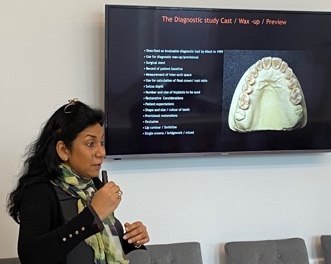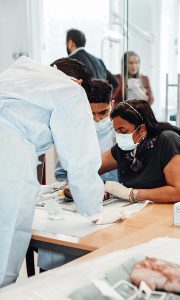Planning against early implant failure
Featured Products Promotional FeaturesPosted by: Dental Design 26th April 2024

Dental implantology has breached the forefront of the profession, and the reliable success that it provides has cemented it as an immense treatment solution for many patient needs. However, there is always room to develop and heighten the ceiling for success when it comes to treatment outcomes.
The failure of a dental implant generally falls into one of two camps: early or late. This depends upon the timing of the implant failure following placement. Early typically suggests an inability to establish osseointegration, whilst late failures come after a breakdown of an established osseointegration or functionality.[i]
Overcoming the first hurdle is key. Generally, early failure is rare, and success rates exceed 95%.i However, to further minimise this, clinicians require a greater understanding of why implants fail early – and why success lies in treatment planning.
Biological problems
 The success of a dental implant depends heavily upon the health of the immediate surrounding soft and hard tissue.[ii] Dental professionals must first assess their patients to see if their health and daily habits stack up to forecast implant survival.
The success of a dental implant depends heavily upon the health of the immediate surrounding soft and hard tissue.[ii] Dental professionals must first assess their patients to see if their health and daily habits stack up to forecast implant survival.
For example, one factor that increases the risk of early implant failure – by as much as 1.3- to 2.3-fold – is smoking,[iii] and it does so through a variety of means. Smoking decreases leukocyte activity whilst reducing the chemotactic migration rate and lowering phagocytic activity. In turn a patient experiences low infection resistance and delayed wound healing, and the latter is only compounded with the presence of carbon monoxide and cyanide, which disrupt healing further.[iv] Therefore, in the weeks and months directly following an implant placement, smokers may observe a hampered recovery, with soft tissue that is prone to the development of infections such as peri-implantitis.
It has a negative impact on hard tissue too, as healing around the implant base may not occur at an optimal rate. This is because smoking can affect the osseointegration process by lowering the blood flow rate, due to increased peripheral resistance and platelet aggregation.iv
Assessing the patient’s risk factors is essential for defining a predictable and achievable treatment plan. This requires clinicians to speak extensively and openly with patients about their general health before deciding on implant treatment, and considering it as part of an effective plan.
Technique trumps all
Many of the opportunities for early implant failure actually lie within the procedure itself.
Heat-induced necrosis and incorrect positioning of the implant have been cited as risk factors.[v] For the former, drilling creates friction at the implant site and, if not properly managed, the heat that is generated can cause a degree of necrosis of the surrounding cells.[vi] As a result, the implant’s chances of successful osseointegration may be compromised.v
Achieving an optimal implant position is a critical part of surgery, and failure to do so can not only damage local biological structures, but result in aesthetic and technical complications.[vii] When an implant is placed in an unfavourable position, such as in an area with low bone density, it may be difficult to secure primary stability,[viii] potentially resulting in early implant failure.
Both of these risks can be avoided with, once again, thorough and considered planning. If the procedure were to fail due to inaccurate preparation, both patients and surgeons could feel a sense of angst.[ix] Taking the time to fully understand the differences that the most minute changes can make is key, allowing you to tailor your approach for successful outcomes.
Starting strong
Getting a dental implant procedure right first time is not only beneficial for a patient’s general health, but it means a second implant doesn’t have to be attempted – there is a reduced chance of success in a previously failed site.ix Working to reduce the chance of early implant failure means a complete consideration of the patient’s health and suitability, and the clinical approach taken.
The support around you could be key, with the chance to identify challenges that a treatment would present, and then devise an actionable and predictable treatment.
With the Postgraduate Diploma in Implant Dentistry from One To One Implant Education, which relaunches May 2024, clinicians can learn to develop treatment plans that reduce the chance of early implant failure, and the latest, most effective techniques to carry out the procedure. The course is excellent for implant dentistry novices who are aspiring to become safe and confident clinicians, with guidance provided from dedicated tutors and mentors who have completed the course before, and developed their own experience in practice.
Early implant failure is rare in modern dentistry. With the advancement of new technology, it may drop even lower. However, it is always within the powers of the clinicians to truly optimise a treatment, and provide successful, long-lasting implants that patients will love.
To reserve your place or to find out more, please visit
https://121implanteducation.co.uk or call 020 7486 0000.
Dr Fazeela Bio
Author bio:
Dr Fazeela Khan-Osborne is the founding clinician of the FACE dental implant multi-disciplinary team for the One To One Dental Clinic based on Harley Street, London. She has always had a passion and special interest in implant dentistry, particularly in surgical and restorative full arch rehabilitation of the maxilla. She has been involved in developing treatment modalities for peri-implantitis within clinical practice.
Dr Khan-Osborne is also the Founding Course Lead for the One To One Education Programme, now in its 20thyear. As a former Lead Tutor on the Diploma in Implant Dentistry course at the Royal College of Surgeons (England), she lectures worldwide on implant dentistry and is an active full member of the Association of Dental Implantology, the British Academy of Aesthetic Dentistry and the International Congress of Oral Implantologists.
Nik Bio
Nikolas is a Senior Implant and Restorative Surgeon in private clinics in London and Edinburgh.
His special interest and main qualifications are in Oral Surgery and Oral Implantology, while he has vast experience in all areas of Aesthetic Dentistry.
He has been a practising Dental Surgeon since 2005 after graduating from the prestigious Military Academy Medical School at the University of Thessaloniki, Greece.
Nikolas started his training in the Oral and Maxillofacial Surgery Department of the 401 Military Hospital in Athens, Greece. As a military officer, he then went on to serve as a team leader in a field hospital in Kabul, Afghanistan – an experience, which shaped his commitment and dedication to his chosen field. On returning to Greece, he furthered his
training completing a Postgraduate Diploma in Oral Implantology from the University of Athens, Greece and a Master of Science Degree in Oral Surgery/Implantology from Göethe University of Frankfurt, Germany.
He recently obtained an Advanced Surgical Master Curriculum in Regenerative Implant Dentistry next to Dr Istvan Urban in Budapest, Hungary.
Nikolas is lecturing about Dental Implants and Regenerative Dentistry, and he is holding a program for introducing and mentoring dentists in Implant Dentistry.
He is a Member of the Association of Dental Implantology and the International Team for Implantology.
[i] Hossain, N., Mobarak, M. H., Islam, M. A., Hossain, A., Al Mahmud, M. Z., Rayhan, M. T., & Chowdhury, M. A. (2023). Recent development of dental implant materials, synthesis process, and failure–a review. Results in Chemistry, 101136.
[ii] Kim, J. J., Lee, J. H., Kim, J. C., Lee, J. B., & Yeo, I. S. L. (2019). Biological responses to the transitional area of dental implants: Material-and structure-dependent responses of peri-implant tissue to abutments. Materials, 13(1), 72.
[iii] Manzano, G., Montero, J., Martín-Vallejo, J., Del Fabbro, M., Bravo, M., & Testori, T. (2016). Risk factors in early implant failure: a meta-analysis. Implant dentistry, 25(2), 272-280.
[iv] Dutta, S. R., Passi, D., Singh, P., Atri, M., Mohan, S., & Sharma, A. (2020). Risks and complications associated with dental implant failure: Critical update. National journal of maxillofacial surgery, 11(1), 14.
[v] Staedt, H., Rossa, M., Lehmann, K. M., Al-Nawas, B., Kämmerer, P. W., & Heimes, D. (2020). Potential risk factors for early and late dental implant failure: a retrospective clinical study on 9080 implants. International journal of implant dentistry, 6, 1-10.
[vi] Jo, K. H., Yoon, K. H., Park, K. S., Bae, J. H., You, K. H., Han, J. H., … & Cheong, J. K. (2011). Thermally induced bone necrosis during implant surgery: 3 case reports. Journal of the Korean Association of Oral and Maxillofacial Surgeons, 37(5), 406-414.
[vii] Tallarico, M., Scrascia, R., Annucci, M., Meloni, S. M., Lumbau, A. I., Koshovari, A., … & Martinolli, M. (2020). Errors in implant positioning due to lack of planning: A clinical case report of new prosthetic materials and solutions. Materials, 13(8), 1883.
[viii] Thiebot, N., Hamdani, A., Blanchet, F., Dame, M., Tawfik, S., Mbapou, E., … & Alantar, A. (2022). Implant failure rate and the prevalence of associated risk factors: a 6-year retrospective observational survey. Journal of Oral Medicine and Oral Surgery, 28(2), 19.
[ix] Abdelhay, N., Prasad, S., & Gibson, M. P. (2021). Failure rates associated with guided versus non-guided dental implant placement: a systematic review and meta-analysis. BDJ open, 7(1), 31.










